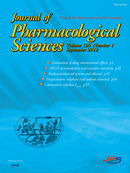Volume 120, Issue 3
Displaying 1-13 of 13 articles from this issue
- |<
- <
- 1
- >
- >|
Current Perspective
-
2012Volume 120Issue 3 Pages 139-145
Published: 2012
Released on J-STAGE: November 16, 2012
Advance online publication: October 26, 2012Download PDF (165K) -
2012Volume 120Issue 3 Pages 146-151
Published: 2012
Released on J-STAGE: November 16, 2012
Advance online publication: October 10, 2012Download PDF (255K)
Critical Review
-
2012Volume 120Issue 3 Pages 152-164
Published: 2012
Released on J-STAGE: November 16, 2012
Advance online publication: October 10, 2012Download PDF (233K)
Full Paper
-
2012Volume 120Issue 3 Pages 165-175
Published: 2012
Released on J-STAGE: November 16, 2012
Advance online publication: October 06, 2012Download PDF (545K) -
2012Volume 120Issue 3 Pages 176-186
Published: 2012
Released on J-STAGE: November 16, 2012
Advance online publication: October 16, 2012Download PDF (272K) -
2012Volume 120Issue 3 Pages 187-195
Published: 2012
Released on J-STAGE: November 16, 2012
Advance online publication: October 20, 2012Download PDF (401K) -
2012Volume 120Issue 3 Pages 196-205
Published: 2012
Released on J-STAGE: November 16, 2012
Advance online publication: October 27, 2012Download PDF (482K) -
2012Volume 120Issue 3 Pages 206-212
Published: 2012
Released on J-STAGE: November 16, 2012
Advance online publication: October 30, 2012Download PDF (513K) -
2012Volume 120Issue 3 Pages 213-227
Published: 2012
Released on J-STAGE: November 16, 2012
Advance online publication: October 26, 2012Download PDF (261K) -
2012Volume 120Issue 3 Pages 228-240
Published: 2012
Released on J-STAGE: November 16, 2012
Advance online publication: October 26, 2012Download PDF (1477K) -
2012Volume 120Issue 3 Pages 241-249
Published: 2012
Released on J-STAGE: November 16, 2012
Advance online publication: October 26, 2012Download PDF (371K)
Short Communication
-
2012Volume 120Issue 3 Pages 250-253
Published: 2012
Released on J-STAGE: November 16, 2012
Advance online publication: October 06, 2012Download PDF (217K) -
2012Volume 120Issue 3 Pages 254-257
Published: 2012
Released on J-STAGE: November 16, 2012
Advance online publication: October 16, 2012Download PDF (219K)
- |<
- <
- 1
- >
- >|
